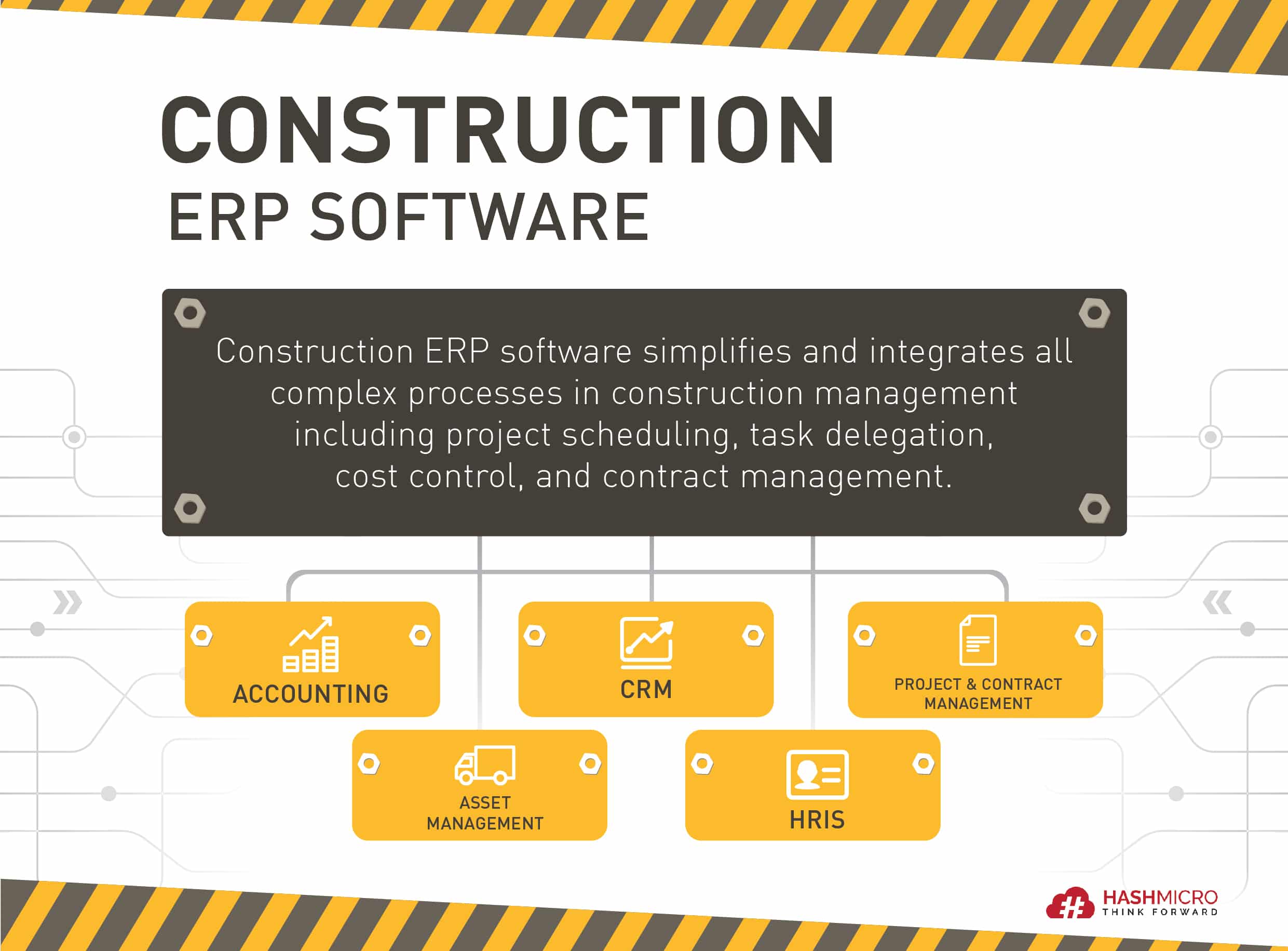Construction management consists of a variety of complex processes, from design, planning, execution, monitoring, to closure. We have covered all of these stages in the first chapter. Today, you will learn about other important matters: how to choose the best construction software, create documentation, deal with risks and failures, and adapt to project changes.
To make it easier for you to understand this article, see the following table of contents.
Table of Contents
- Choose the Right Construction Management Software
- Report Status on a Project
- Mitigate Risks in Construction
- Deal with Project Failure
- Keep Up with Changes
- Conclusion
How to Choose the Right Construction Management Software
ERP software has proven to simplify complex construction processes, especially in recent years. And not only that. ERP systems also make project delivery faster and more precise, increase collaboration, and provide complete visibility throughout the construction supply chain.
Since every ERP system has its own advantages and disadvantages, choosing the best one can be a bit of a headache. You need to ensure that the ERP system you choose is specifically for the construction industry. In addition, several factors that you need to consider are
Real-Time Updates
Real-time information is one of the main features that you should look for in an ERP system. It is crucial in construction management to make it easier for project managers and contractors to convey progress and changes to stakeholders as they occur
Forecasting Ability
ERP software is equipped with forecasting tools that allow you to estimate costs, raw materials, revenues, and profits. These tools have a major effect on cost efficiency and the decision to work on projects in the future.
Integration with Other Systems
ERP integration with other systems is vital to complete the automation. However, not all ERP systems allow this. If integration is the function you need, make sure to ask your potential vendor whether or not their ERP system can be integrated with other systems that you use such as construction software.
How to Report Status on a Project
Various tasks are executed on the construction site every day. It is critical that every job is well documented and every issue is reported. Changes often occur, even contradicting the original plan. This is where the documentation becomes very important.
However, paper-based or spreadsheet documentation is ineffective since it is not saved in a centralized location, easily misplaced, damaged, and lost. Fortunately, with the advent of ERP software, construction project documentation has become more efficient and simpler. the document management system can reduce paper usage and is environmentally friendly through cloud servers.
All progress is recorded digitally and stored in a centralized repository. All parties who have access to documentation will automatically get notified whenever there is an update.
How to Mitigate Risks in Construction
Construction projects aren’t immune from risks. Therefore, solid construction risk management is a must-have. Your project team must be familiar with various types of risks that may arise during project execution:
- Low or negative margins
- Health and safety risks
- Project disputes
- Budget overruns and substantial delays in the project completion
- High rate of rework
- The need to generate high ROI based on funds invested in the project
- Lack of transparency or miscommunication throughout the supply chain
- Data breach
- Bureaucracy and heavy administrative demands
- Unforeseen factors such as extreme weather phenomena and social chaos
The above risk factors show how complex the construction industry is and how fundamental it is to invest in automated solutions to integrate the entire process. Risk analysis is also highly necessary so that the impact of risks will reduce. The following are a few things that a construction manager can do:
Find out potential sources of risk
Risks can come from various sources. They can occur in the work environment, finance, contracts, projects, or stakeholders. Finding the cause of the risk will make it easier for you to overcome it.
Sort the severity of the risk
Once you know the source of risk, then you can sort all the risks based on the severity. This way, you will be able to prioritize risk management more easily.
Use the right resources to deal with risks
Using ERP software has proven to help reduce risks in construction management, especially financial and project risks, through its forecasting ability. While in terms of safety, life and safety insurance can be very helpful. You also need to consider hiring a consultant who can give advice on how you should deal with risks, especially those relating to contracts.
Involve your entire team in dealing with risks
Everyone must know and contribute to good risk management according to their role in the construction business. Discussion of risk must be part of communication at all levels. By having a centralized and integrated platform, you will be able to easily disseminate risk-related information to the entire team and stakeholders.
How to Deal with Project Failure
Construction projects can lead to failure for various reasons. Here are some of the most common causes of failure:
1. Fragmented Supply Chain
Lack of clear hierarchy and direct information flow can result in fragmented supply chains. Having too many decision-makers in one place can ultimately hamper collaboration and confuse the project team. This is one of the most common obstacles that construction project managers need to overcome today.
2. Poor work habits
One of the biggest enemies of construction projects and entire sectors is bad work habits. The reluctance of construction agencies to change the way they work and adopt new, more digital approaches is a big challenge for the sector.
3. Lack of trust in contractual relationships
Contractual relationships are often a source of problems for the smooth running of construction projects. There have been many cases where construction sites were inactive for weeks, even months, due to miscommunication or lack of trust between subcontractors. This could have a serious impact on the final cost of the project.
Whatever the cause of your project failure, there is always the same way to deal with it, which is negotiation. Discuss with stakeholders whether it is possible to spin out time to complete the project. Offer several alternative solutions that are mutually beneficial. If the mediation process is unsuccessful and a dispute occurs, it is necessary to ask the help of a professional mediator or lawyer to find a foundation and reach a mutual agreement
How to Keep Up with Changes
Changes in construction management are very common. Although changes aren’t always bad, there are times when this makes everyone on the team confused. You surely don’t want changes that are too far from the initial plan, so you should state this in your contract. Here are some things you can do when facing changes:
1. Identify the types of changes
The first step, of course, is to find out the types of changes that have arisen. Figure out whether it is a forced change or a change initiated by a stakeholder. Some points that must be considered by the team and all parties are why this change is needed, who caused it, and how it can affect team performance and communication.
2. Communicate with all parties
After the changes have been identified, you then need to communicate them with all parties involved. This is where decisions about when and how changes will be implemented must be taken.
3. Make priority when changes are implemented
Implementing a new strategy is not easy. To ensure smooth running in this matter, you must have a priority list. Make sure everyone complies with the priorities set.
4. Analyze changes that have been made
Last but not least, you need to analyze whether the new practices implemented are working as planned. If the changes can add value to the project and make teamwork easier, that means you have made a real difference to your business.





































